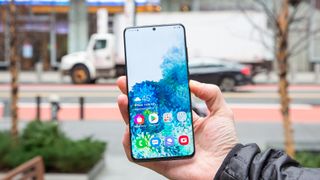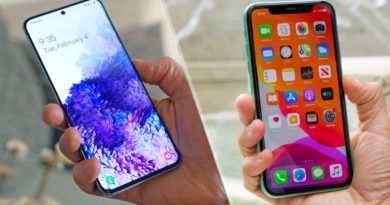AT&T 5G network rollout: Locations, phones, price and more
While 5G may have emerged in 2019, this year has seen 5G truly take shape around the United States. AT&T is one of the latest to the nationwide 5G party, having rolled out its wide-spanning sub-6GHz 5G service to the masses this July.
Granted, even though AT&T considers its 5G network nationwide, it still has a long way to go before it reaches all the way to the door of each and every American. As it stands, AT&T’s 5G service is said to cover more than 200 million people in 395 markets around the country. Looking at the map, there’s still large swaths of the East Coast, Midwest and Great Plains that still rely on the carrier’s 4G LTE service.
Here’s how AT&T’s 5G network is shaping up and what it means for performance, wireless data plan prices and handset availability.
AT&T 5G bands
First off, it’s critical to explain how AT&T splits its 5G service up. There’s the nationwide sub-6GHz service mentioned above, which offers speeds about as fast, if not slightly better than 4G LTE. In spite of AT&T’s “nationwide” banner, this isn’t available everywhere yet, though it’s much more common to find than AT&T’s 5G Plus network, which involves a completely different kind of technology.
5G Plus is AT&T’s name for its millimeter-wave (mmWave) 5G infrastructure. When you hear carriers advertise data speeds in excess of 1 Gbps or downloading entire movies or seasons of TV shows in a minute, this is the kind of 5G they’re referring to. But while millimeter-wave 5G offers exponentially faster speeds than sub-6GHz 5G or 4G LTE, it is exponentially more limited in terms of range, which is why it’s only available in cities or high-traffic indoor spaces.
AT&T 5G cities and coverage map

AT&T’s 5G Plus can only be found in 35 cities in 17 states at the time of this writing. California has the most 5G Plus-supported cities by far, at 9 of the total 35. You can find a comprehensive list on AT&T’s website. Of course, you will also need a compatible 5G-supported phone to benefit from 5G coverage — more on that later.
AT&T’s long-range 5G service covers more than 200 million Americans, according to the carrier. That pales somewhat to the 250 million-strong coverage across 7,500 cities of T-Mobile’s 5G, though both networks are actively growing all the time.
AT&T 5G speeds
AT&T’s 5G infrastructure has made significant strides over the past two years. Initially, the carrier’s 5G Plus service topped out at 400 Mbps. In February 2019, AT&T reported that had improved to a peak throughput of 2 Gbps on its commercial network in Atlanta. That is fast enough to download a 2-hour HD film in 10 seconds.
Unfortunately, we didn’t quite see that kind of performance when we conducted hands-on testing of AT&T’s 5G Plus service in Las Vegas in the summer of 2019. At that time, we recorded peak speeds just shy of 1 Gbps — far better than LTE, of course, but a good sight off the 1.5 Gbps average speed claims the carrier had made at the time. Additionally, it was very difficult to track down a signal in our experience, owing to 5G Plus’ limited range.
AT&T’s standard 5G service, built on sub-6GHz infrastructure, is far easier to locate, in exchange for speeds a fraction as fast. As a point of comparison, T-Mobile’s 5G network is built on the same low-band spectrum AT&T uses for its nationwide network (that is, not 5G Plus), and the speeds we’ve seen there are at best only slightly faster than what we get from LTE.
In fact, oftentimes 5G speeds are barely quicker than LTE. Case in point, OpenSignal’s recent report on the average download speeds of the nation’s major 5G networks found AT&T finishing second among the Big Four at 60.8 Mbps. That’s hardly a generational leap when you consider that the fastest LTE Advanced signals can carry three to four times that throughput. Verizon came in first, averaging 494 Mbps, though of course its mmWave-only infrastructure taints the comparison somewhat.
In terms of availability, AT&T finished third at 10.3% of its subscribers able to connect to 5G, with T-Mobile and Sprint coming first and second at 22% and 14%, respectively. T-Mobile and Sprint have joined forces since this study was conducted, so you can figure T-Mobile’s reach has grown since then.
AT&T 5G phones and devices

Most new flagship phones arriving this year support AT&T’s 5G network, though the type of 5G they work with differs on a case-by-case basis. Some handsets, like the Samsung Galaxy S20, only sport sub-6GHz connectivity and skip out on millimeter-wave signals (though Samsung has since released a variant of the Galaxy S20 specifically to work with Verizon’s mmWave network). Other phones, like the Galaxy S20 Plus and Galaxy Note 20 Ultra, support both 5G configurations, for the fastest possible speeds in any condition.
You may have noticed a theme there. Indeed, the vast majority of 5G handsets available today and through AT&T are Samsung devices. That will likely change once Apple unveils the iPhone 12 this fall. Rumors suggest we’ll get four new iPhones this year, and all of them will support 5G in at least sub-6GHz form.
At least AT&T offers a pretty compelling range of 5G phones at various price points. On the low end, you have the Samsung Galaxy A71 5G, which costs $599 in total, though AT&T is currently offering a $10-per-month promotional cost for new customers activating lines.

Samsung Galaxy A71 5G: $599 @ AT&T
The Galaxy A71 5G is one of the cheapest 5G-ready devices AT&T offers. This phone sports a Snapdragon 765 processor for strong performance as well as a big 6.7-inch display despite its relatively low price. You can get it for a very reasonable $10 per month over 30 months.View Deal
On the other end of the spectrum is the Samsung Galaxy Z Flip 5G — a device that not only supports 5G but is also foldable, and is pretty much just as expensive as you’d imagine such a phone would be. The Galaxy Z Flip 5G costs $1,449 at AT&T and breaks down to $48.34 over 30 months.

Samsung Galaxy Z Flip 5G: $1,449 @ AT&T
The Galaxy Z Flip 5G is one of the priciest devices AT&T offers, breaking down to $48.34 per month if you finance the device over a period of 30 months. There’s only one configuration of this device, with 256GB of built-in storage.View Deal
However, while the A71 5G and Galaxy Z Flip 5G may differ wildly in terms of price, they are similar in that they only support sub-6GHz networks. If you want a phone that can take advantage of 5G Plus and its incredible speed, you’ll need one of those larger S20 handsets, or one of the just-released Galaxy Note 20 models.

Samsung Galaxy Note 20 Ultra: $1,299 @ AT&T
You can pay off the Note 20 Ultra over 30 months with payments of $43.34 a month, though AT&T has a promotion running now that can slash up to $1,000 off the device for customers switching with an eligible trade in.View Deal
If you’re not smitten with any of Samsung’s offerings, LG offers a 5G phone of its own. Called the LG V60 5G ThinQ, this phone is a bit cheaper than Samsung’s equivalent 5G options, at $899. That breaks down to $30 per month.

LG V60 ThinQ: $899 @ AT&T
Open a new line at AT&T with a qualifying unlimited plan, and you can get $700 off on the LG V60 ThinQ, reducing the phone’s price to $199.View Deal
AT&T 5G hotspots
AT&T’s first 5G-compatible product was actually the Netgear Nighthawk, a hotspot that could pull in a 5G signal and blast it to your supported devices over Wi-Fi. This device was ultimately discontinued, but now AT&T is now replacing it with a successor, called the Netgear Nighthawk 5G Mobile Hotspot Pro.
The new Nighthawk model supports Wi-Fi 6, meaning you’ll lose as little speed as possible from that 5G connection when tethering. It also can service up to 32 devices. The Nighthawk 5G Mobile Hotspot Pro goes on sale Sept. 18 for $509.
AT&T’s Unlimited Extra and Unlimited Elite plans include hotspot data. But the allotment of hotspot data — 30GB for Elite and 15GB for Extra — runs at 4G speeds.
AT&T 5G plans: What you’ll pay
Here’s the good news: AT&T doesn’t charge extra for 5G service across its three unlimited plans. However, depending on how much you spend and what tier you select, you’ll get more or less full-speed data before AT&T starts throttling you or deprioritizing your service behind that of other users.
The base $65/month Unlimited Starter plan slows your service at any time when AT&T’s network is stressed. That means that although it includes 5G service, the consistency of that service may be in flux from moment to moment. To get the best possible data speeds, you’ll want to at least choose the $75/month Unlimited Extra plan, which allots 50GB of full-speed data, whether you’re on 4G or 5G. The $85/month Unlimited Elite plan doubles that allotment to 100GB before you run the risk of being slowed. See how AT&T’s pricing compares in our look at the best unlimited data plan for each wireless carrier.
AT&T 5G outlook
Nearly two years since AT&T launched its first 5G Plus market, the carrier’s 5G deployment is finally reaching a point where many of its customers can take advantage of it. That’s thanks to the launch of the carrier’s nationwide sub-6GHz network as well as the rash of 5G-capable phones that have been dropping throughout 2020.
AT&T customers living in an urban area covered by both the carrier’s regular and 5G Plus services have the unique opportunity to take advantage of both faster speeds and more extensive coverage. And that will only continue in the coming months, as AT&T expands the reach of both types of 5G infrastructure.
The rest of 2020 looks to be an especially important period in AT&T’s 5G development, as the carrier says it will roll out dynamic spectrum sharing in the months ahead. This technology will allow AT&T to use the same spectrum channel for both 5G and LTE, but give priority to one or the other based on network conditions. While DSS won’t necessarily add to AT&T’s 5G capacity, it could expedite the carrier’s transition from a mostly LTE-based network to a mostly 5G-based one in the years ahead, as progressively more people buy 5G handsets.


